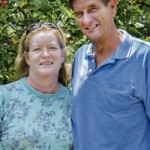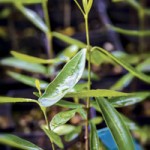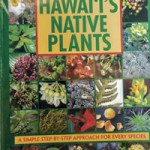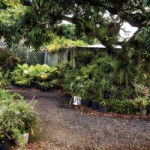A Hawaiian Heritage Plant
In 1989, Kerin Rosenberger was the nursery manager for the rare and endangered plants at National Tropical Botanical Garden (NTBG) in Lawai. She carefully documented each species, and her collection of notebooks was turned into the book, Growing Hawai‘i’s Native Plants.
The book covers 1,191 true existing native Hawaiian plant species. For each entry there is a species description, information on provenance, growing methods, germination rates, pest and disease control and directions for out-planting.
“Native plants are plants that got here without the aid of man,” says Kerin. “They came by wing, wind and waves. Like the ohia lehua (a common tree in the Hawaiian Islands), their seeds are so fine they’re like dust, and they came in the jet stream.”
A gravel path winds though the couple’s 1.5-acre property and leads you through a well-maintained jungle flourishing with rare and endangered native and non-native plants. Here, Kerin collects and propagates seeds, and George sells them at the farmers market. “About 75 percent of the plants I sell are native,” says George. “They include koa, mamaki, hibiscus and maile.”
What’s growing now: Awa, breadfruit, Hawaiian cotton, hibiscus (native to Kaua‘i), koa, kokolau, maile, mamaki, paper mulberry (wauke), sandalwood (lowland), kalo.
- Kerin and George Rosenberger. Daniel Lane photos
- Maile seedlings available at the KCC Market
- The greenhouse at the Rosenbergers’ home
- Kerin wrote this book after working at NTBG
MAILE
Alyxia oliviformis is generally a twining vine or a sprawling shrub. The leaves and bark have a pleasant fragrance that is released when they are crushed or twisted, and increases as the vines dry out.
Traditionally, Hawaiians used maile to scent kapa cloth and as perfume. The flowers, seeds, leaves and vine are used in lei-making. Prized by the ancient Hawaiians as the most noble of lei materials, maile is the only endemic species now commercially grown for lei.
In the mountains of Kaua‘i, maile is declining because of overharvesting of new tips. “The locals know it’s a problem,” says Kerin. “A Hawaiian group just purchased 150 maile plants from us and out-planted them in the mountains.” Uncollected, the vine will grow along the ground and up trees.
Lore: Maile is referred to in song, hula and chant and was dedicated to Laka, Goddess of Hula, and placed on her altars.
Habitat: Maile grows in a wide variety of habitats ranging from dry areas to wet forests. It occurs from near sea level to elevations of 6,500 feet.
Description: The leaves are smooth and glossy, dark green on top and paler underneath. The leaves can be up to 3 1/2 inches long and occur in groups of two, three or four. Tiny flowers are greenish to yellowish white, and the fruit is oval and dark purple when ripe. They are divided into two, three or four segments, each of which contains a seed.
Preparation: Plant seedlings in a 1-gallon pot and let them grow twice as tall as the pot. Out-plant in a shady, moist area, preferably near a tree so it can grow up. If not, it will be a ground cover.
Tip: Kerin recommends ripening the fruit in a plastic bag to soften the pulp. After this, the seeds can be removed from the pulp more easily. This can be done by soaking them in cold water for 24 hours. Wash the seeds thoroughly.
“I wrote the book to take the fear out of native plants,” Kerin says. “For 10 years I kept hearing, ‘You can’t do this,’ ‘You can’t grow koa here,’ ‘You can’t do that.’ I created a forest in my yard, and I put things in it they say you can’t, so I could see for myself. I did it. I was growing maile at sea level. All I did was give the plant what it needs.
“My book can show anybody how to collect the seed, how to start the seed, what media to use, what the plant looks like, how to out-plant it, care for it, what bugs it’s going to get and how to take care of those bugs. That way people can just plant them.
“I feel so sorry for these plants. Why are they so rare and endangered? Why aren’t they in people’s yards? Why is it only about plumerias and bird-of-paradise?”
Keep It Native can be found at: Farmers Markets: Kaua‘i Community Market (Saturdays at 9:30 a.m.) at Kaua‘i Community College. Call 742-9484 or email kerinr@hawaiiantel.net.
Marta Lane is a Kaua‘i-based food writer. For more information, visit TastingKauai.com.







